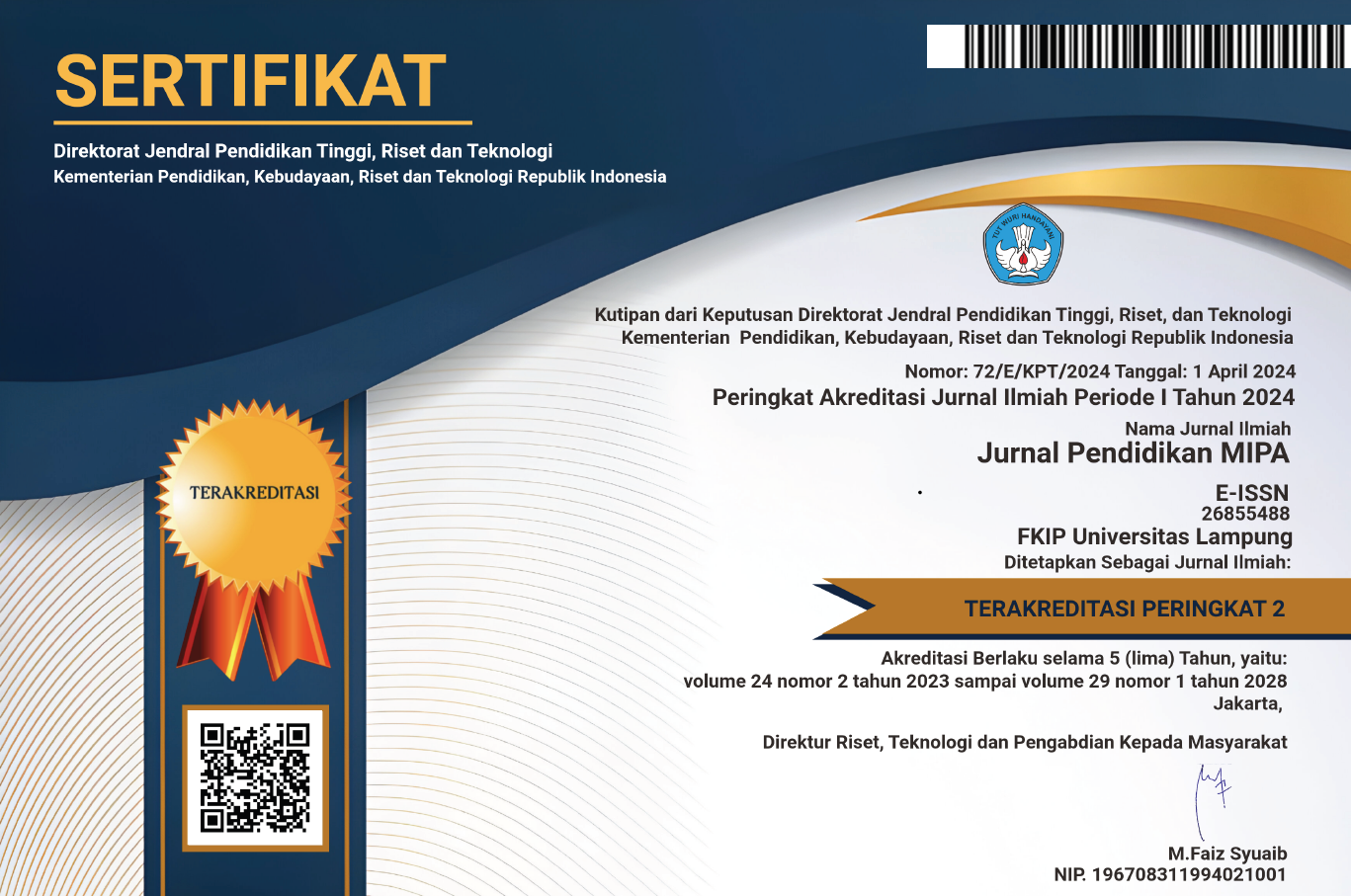High School Students’ Ability with Translation Among Mathematical Representations in Solving the HOTS-Based Problems
 Country:
Country:
(1) Universitas Negeri Malang, Indonesia
(2) Universitas Negeri Malang, Indonesia
(3) Universitas Negeri Malang, Indonesia
| Metrics→ |
| Indexing Site→ |
Copyright (c) 2022 Azizah Nur Laily Rahmawati, Cholis Sa’dijah, Lathiful Anwar
Translation is considered as a step in transforming the information contained from the source representation to the destination representation. In the process of students doing mathematical translation there are four stages of activity, Unpacking the Source, Preliminary Coordination, Constructing the Target, and Determining Equivalence. This study aims to analyze the activities carried out by students in translating representations from graphic to symbolic, table to symbolic, and verbal to symbolic based on HOTS. This research was conducted at SMA Lamongan Regency with three research students in class XI who had learned about the concept of quadratic functions. The instruments used were translation questions and interview guidelines. The applied data analysis focused on four stages of translation activity which were then grouped according to (high, medium, and low categories). The results showed that the translation of verbal representations into symbolic ones was the most difficult for students to complete.
Keywords: mathematical translation, representation, HOTS.
Ahmad, J., Rahmawati, D., & Anwar, R. B. (2020). Proses translasi representasi siswa dalam menyelesaikan permasalahan matematika yang berorientasi pada high order thinking skills. AKSIOMA: Jurnal Program Studi Pendidikan Matematika, 9(3), 631–640.
Aisyah, A. S. N., & Madio, S. S. (2021). Peningkatan kemampuan representasi matematis siswa dengan pembelajaran berbasis masalah melalui pendekatan konstekstual dan matematika realistik. Plusminus: Jurnal Pendidikan Matematika, 1(2), 363–372.
Rahmawati, D. (2017, July). Translasi representasi matematis verbal ke grafik pada materi fungsi. In Prosiding SI MaNIs (Seminar Nasional Integrasi Matematika Dan Nilai-Nilai Islami) (Vol. 1, No. 1, pp. 557–563).
Adu-Gyamfi, K., Bossé, M. J., & Chandler, K. (2015). Situating student errors: Linguistic-to-algebra translation errors. International Journal for Mathematics Teaching & Learning.
Bossé, M. J., Adu-Gyamfi, K., & Chandler, K. (2014). Students’ differentiated translation processes. International Journal for Mathematics Teaching and Learning, 828, 1–28.
Bossé, M. J., Adu-Gyamfi, K., & Cheetham, M. R. (2011). Assessing the difficulty of mathematical translations: Synthesizing the literature and novel findings. International Electronic Journal of Mathematics Education, 6(3), 113–133.
Caverly, R. H. (2019). Theory into practice [From the Editor's Desk]. IEEE Microwave Magazine, 20(9), 6–10.
Cuoco, A. A., & Curcio, F. R. (2001). The roles of representation in school mathematics. National Council of Teachers of Mathematics.
Hutagaol, K. (2013). Pembelajaran kontekstual untuk meningkatkan kemampuan representasi matematis siswa sekolah menengah pertama. Infinity Journal, 2(1), 85–99.
Klieme, E. (2016). TIMSS 2015 and PISA 2015: How are they related on the country level. Deutsches Institut für Internationale Pädagogische Forschung.
Ma’rufi, M. R., Ilyas, M., & Pasandaran, R. F. (2019). Higher order thinking skills (HOTS) first middle school of class VIII students in completing the problem of polyhedron. In The 7th South East Asia Design Research International Conference (SEADRIC 2019). IOP Publishing.
Sitompul, N. C. (2019). Exploring the implementation of weblog-based flipped classroom in teaching civics: Is it feasible and effective? International Journal of Instruction, 12(4), 239–250.
Moscovici, S. (1988). Notes towards a description of social representations. European Journal of Social Psychology, 18(3), 211–250.
Muhamad, N. (2017). Pengaruh metode discovery learning untuk meningkatkan representasi matematis dan percaya diri siswa. Jurnal Pendidikan UNIGA, 10(1), 9–22.
Nugrahani, F. (2014). Metode penelitian kualitatif dalam penelitian pendidikan bahasa (Vol. 1, Issue 1). Cakra Books.
Nurrahmawati, C. S. D., Sa’dijah, C., Sudirman, S., & Muksar, M. (2021). Assessing students’ errors in mathematical translation: From symbolic to verbal and graphic representations. International Journal of Evaluation and Research in Education, 10(1), 115–125.
Purnomo, H., Sa’dijah, C., Cahyowati, E. T. D., Nurhakiki, R., Anwar, L., Hidayanto, E., & Sisworo. (2021, March). Gifted students in solving HOTS mathematical problems. In AIP Conference Proceedings (Vol. 2330, No. 1, p. 040008). AIP Publishing LLC.
Prahastuti, S., Hidayat, M., Hasianna, S. T., Widowati, W., Amalia, A., Yusepany, D. T., ... & Kusuma, H. S. W. (2019, November). Antioxidant potential ethanolic extract of Glycine max (L.) Merr. Var. Detam and daidzein. In Journal of Physics: Conference Series (Vol. 1374, No. 1, p. 012020). IOP Publishing.
Sa’dijah, C., & Sa’diyah, M., Sisworo, & Anwar, L. (2021). Disposisi matematika siswa untuk memecahkan masalah HOTS berdasarkan gaya kognitif FI dan FD. AIP Conference Proceedings, 2215(1), 060025.
Sa’dijah, C., Murtafiah, W., Anwar, L., Nurhakiki, R., & Cahyowati, E. T. D. (2021). Teaching higher-order thinking skills in mathematics classrooms: Gender differences. Journal on Mathematics Education, 12(1), 159–180.
Subanji, S., & Nusantara, T. (2013). Karakterisasi kesalahan berpikir siswa dalam mengonstruksi konsep matematika. Jurnal Ilmu Pendidikan Universitas Negeri Malang, 19(2), 102613.
Susiswo, Sa’dijah, C., Nurjanah, M. T., & Anwar, L. (2021, March). Schematic representation: Solving TIMSS problems in algebra content. In AIP Conference Proceedings (Vol. 2330, No. 1, p. 040001). AIP Publishing LLC.
Syafri, F. S. (2017). Kemampuan representasi matematis dan kemampuan pembuktian matematika. Jurnal e-DuMath, 3(1).
Widana, I. W. (2017). Modul penyusunan soal higher order thinking skill (HOTS).
Refbacks
- There are currently no refbacks.

This work is licensed under a Creative Commons Attribution-ShareAlike 4.0 International License.

The copyright is reserved to The Jurnal Pendidikan MIPA that is licensed under a Creative Commons Attribution-ShareAlike 4.0 International License.


